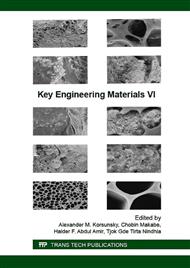[1]
B. Adhikari, D. De, S. Maiti, Reclamation and recycling of waste rubber, Prog. Polym. Sci. 25 (2000) 909-948.
Google Scholar
[2]
K. Harrison, S. G. Tong, N. C. Hilyard, An economic evaluation cryogenic-grinding of scrap automotive tyres, Conserv. Recycl. (1986) 9 1-14.
DOI: 10.1016/0361-3658(86)90128-1
Google Scholar
[3]
G. R. Daborn, R. Derry, Cryogenic comminution in scrap recycling, Conserv. Recycl. 1 (1988) 49-63.
Google Scholar
[4]
Y. Fang, M. Zhan, Y. Wang, The status of recycling of waste rubber. Matl Desg. 22 (2001) 123-128.
Google Scholar
[5]
S. Ramarad, M. Khalid, C. T. Ratman, A. Luqman Chuah, W. Rashmi, Waste tire rubber in polymer blends: A review on the evolution, properties and future, Prog. Matl Sci. 72 (2015) 100-140.
DOI: 10.1016/j.pmatsci.2015.02.004
Google Scholar
[6]
M. Hadad, An experimental investigation of the effects of machining parameters on environmentally friendly grinding process, J. Clnr. Prod. 108 (2015) 217-231.
DOI: 10.1016/j.jclepro.2015.05.092
Google Scholar
[7]
B. Denkena, T. Grove, T. Gottsching, Grinding with patterned grinding wheel, CIRP J. Mfg. Sci. Tech. 8 (2015) 12-21.
Google Scholar
[8]
A. Gosh, P. Antony, A. K. Bhattacharya, A. K. Bhowmick, S. K. De, Replacement of virgin rubbers by waste ground vulcanizates in blends of silicone rubber and fluororubber based on tetrafluoroethylene/propylene/vinylidene fluoride terpolymer, J. Appl. Polym. Sci. 82 (2001).
DOI: 10.1002/app.2081
Google Scholar
[9]
A. Gosh, B. Kumar, A. K. Bhattacharya, S. K. De, Effects of blend ratio and vulcanizate powders on the processability of silicone rubber/fluororubber blends, J. Appl. Polym. Sci. 88 (2003) 2377-2387.
DOI: 10.1002/app.11851
Google Scholar
[10]
A. Gosh, R. S. Rajeev, A. K. Bhattacharya, A. K. Bhowmick, S. K. De, Recycling of silicone rubber waste: effect of ground silicone rubber vulcanizate powder on the properties of silicone rubber, Polym. Engg Sci. 43 (2003) 279-296.
DOI: 10.1002/pen.10024
Google Scholar
[11]
B. Pajarito, C.A. De Torres, M. Maningding, Effect of ingredient loading on surface migration kinetics of additives in vulcanized natural rubber compounds, Sci. Diliman 26 (2014) 21-39.
Google Scholar
[12]
G. E. Christidis, D. Moraetis, E, Keheyan, L. Akhalbedashvili, N. Kekelidze, R. Gevorkyan, H. Yeritsyan, H. Sargsyan, Chemical and thermal modification of natural HEU-type zeolitic materials from Armenia, Georgia and Greece, Appl. Cl. Sci. 24 (2003).
DOI: 10.1016/s0169-1317(03)00150-9
Google Scholar
[13]
M. A. López-Manchado, B. Herrero, M. Arroyo, Preparation and characterization of organoclay nanocomposites based on natural rubber, Polym. Int. 57. 2 (2003) 1070-1077.
DOI: 10.1002/pi.1161
Google Scholar
[14]
S. Chakraborty, R. Sengupta, S. Dasgupta, R. Mukhopadhyay, S. Bandyopadhyay, M. Joshi, S. Ameta, Synthesis and characterization of in situ sodium‐activated and organomodified bentonite clay/styrene–butadiene rubber nanocomposites by a latex blending technique, J. Appl. Polym. Sci. 113. 2 (2009).
DOI: 10.1002/app.30146
Google Scholar
[15]
G. J. Van Amerongen, Oxidative and nonoxidative thermal degradation of rubber, I. Engg Chem. 47. 12 (1955) 2565-2574.
DOI: 10.1021/ie50552a054
Google Scholar


